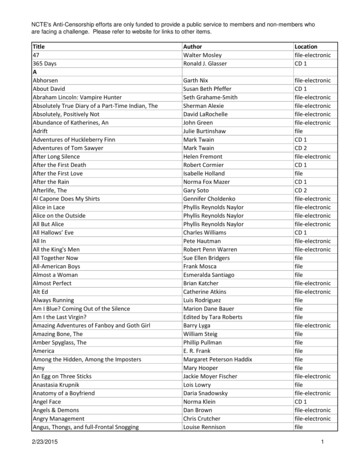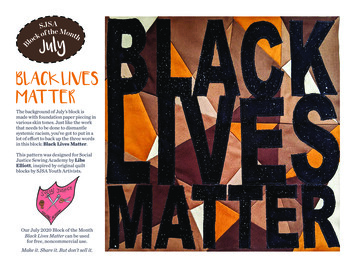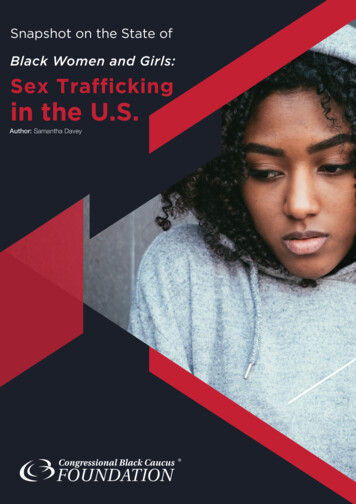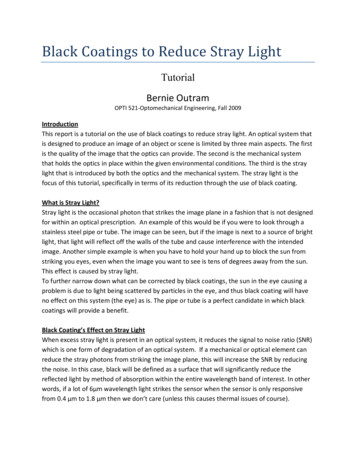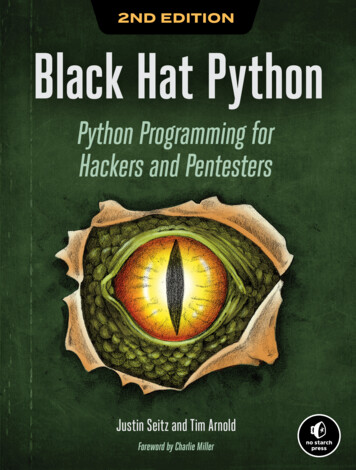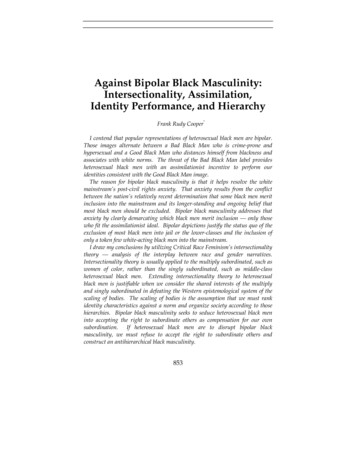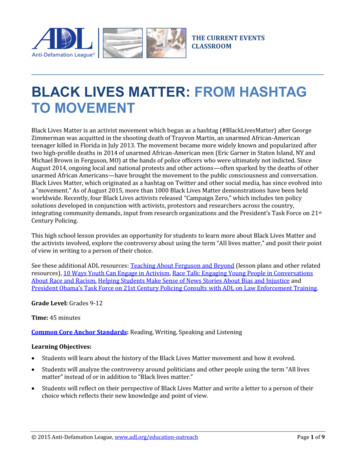
Transcription
THE CURRENT EVENTSCLASSROOMBLACK LIVES MATTER: FROM HASHTAGTO MOVEMENTBlack Lives Matter is an activist movement which began as a hashtag (#BlackLivesMatter) after GeorgeZimmerman was acquitted in the shooting death of Trayvon Martin, an unarmed African-Americanteenager killed in Florida in July 2013. The movement became more widely known and popularized aftertwo high-profile deaths in 2014 of unarmed African-American men (Eric Garner in Staten Island, NY andMichael Brown in Ferguson, MO) at the hands of police officers who were ultimately not indicted. SinceAugust 2014, ongoing local and national protests and other actions—often sparked by the deaths of otherunarmed African Americans—have brought the movement to the public consciousness and conversation.Black Lives Matter, which originated as a hashtag on Twitter and other social media, has since evolved intoa “movement.” As of August 2015, more than 1000 Black Lives Matter demonstrations have been heldworldwide. Recently, four Black Lives activists released “Campaign Zero,” which includes ten policysolutions developed in conjunction with activists, protestors and researchers across the country,integrating community demands, input from research organizations and the President’s Task Force on 21stCentury Policing.This high school lesson provides an opportunity for students to learn more about Black Lives Matter andthe activists involved, explore the controversy about using the term “All lives matter,” and posit their pointof view in writing to a person of their choice.See these additional ADL resources: Teaching About Ferguson and Beyond (lesson plans and other relatedresources), 10 Ways Youth Can Engage in Activism, Race Talk: Engaging Young People in ConversationsAbout Race and Racism, Helping Students Make Sense of News Stories About Bias and Injustice andPresident Obama’s Task Force on 21st Century Policing Consults with ADL on Law Enforcement Training.Grade Level: Grades 9-12Time: 45 minutesCommon Core Anchor Standards: Reading, Writing, Speaking and ListeningLearning Objectives: Students will learn about the history of the Black Lives Matter movement and how it evolved. Students will analyze the controversy around politicians and other people using the term “All livesmatter” instead of or in addition to “Black lives matter.” Students will reflect on their perspective of Black Lives Matter and write a letter to a person of theirchoice which reflects their new knowledge and point of view. 2015 Anti-Defamation League, www.adl.org/education-outreachPage 1 of 9
The Current Events Classroomadl.org/curriculum-resourcesCompelling Question:How did Black Lives Matter transform itself from a hashtag into a political activist movement and why?Material: #BlackTwitter After #Ferguson video (August 10, 2015, 6 mins., The New York cktwitter-after-ferguson.html) “How Black Lives Matter moved from a hashtag to a real political force” (The Washington Post, August19, 2015, al-political-force/), one for each student Quotes About “All Lives Matter” (cut into individual quotes/strips; one quote per student) My Notes on “All Lives Matter” Quotes (one for each student) Campaign Zero Policy Solutions (to project on board/smart board)Vocabulary:Review the following vocabulary words and make sure students know their meanings. (See ADL’s “Glossaryof Education Terms.”) activist controversy incarceration organize tactics campaign demands inclusive privilege targeted color blind hashtag movement racial disparities trauma condemned implicit nascent systemicWHAT IS BLACK LIVES MATTER?1. On the board/smart board, write: “Black Lives Matter.” Ask students: Have you ever seen thisexpression? What does it mean? What do you know about it? How do you feel about it? Have students do aquick brainstorm about Black Lives Matter and record their responses on the board/smart board.2. Share the following basic information about the Black Lives Matter movement: Black Lives Matter is an activist movement which began as a hashtag (#BlackLivesMatter) whenGeorge Zimmerman was acquitted in the shooting death of Trayvon Martin, an unarmed AfricanAmerican teenager killed in Florida in July 2013. The Black Lives Matter movement became more widely acknowledged and popularized after twohigh-profile deaths of unarmed African-American men (Eric Garner in Staten Island, NY and MichaelBrown in Ferguson, MO) in 2014 and in which police officers involved in their deaths were notindicted. Due to the deaths of other unarmed African Americans, ongoing local and nationalprotests and other actions have brought awareness of the issues and the movement to the generalpublic. While Black Lives Matter began as a hashtag on Twitter and other social media, it has since evolvedinto a “movement.” As of August 2015, more than 1000 Black Lives Matter demonstrations havebeen held worldwide. Recently, four Black Lives activists released “Campaign Zero,” which includesten policy solutions developed in conjunction with activists, protestors and researchers across the 2015 Anti-Defamation League, www.adl.org/education-outreachPage 2 of 9
The Current Events Classroomadl.org/curriculum-resourcescountry, integrating community demands, input from research organizations and the President’sTask Force on 21st Century Policing.NOTE: If time permits, project the Campaign Zero Policy Solutions and after reading each category title,ask students what they think that policy solution is about and then briefly describe each solution bysharing information from the website: Campaign Zero: Solutions Overview.3. Ask students: What more do you want to know about Black Lives Matter? Explain that they will learnmore by watching a video about three of the activists and reading an article.4. Show the six-minute video #BlackTwitter After #Ferguson, which highlights three activists—DeRayMcKesson, Johnetta Elzie and Zellie Imani—involved in the Black Lives Matter movement andaddresses the ways in which social media helped facilitate their activism.NOTE: It is advisable for you to preview the video in advance to make sure it is appropriate for yourstudents’ viewing. There are images of teargas, adversarial interactions between police and protestors,people being shot (e.g. William Scott) and dead bodies (e.g. Michael Brown). Most of these images havebeen shown on television. If students need to process their thoughts and feelings in more depth afterwatching the video, allow time for that.5. After watching the video, engage students in a discussion by asking the following questions: How did you feel while watching the video? How did technology (video) and social media (Twitter, Instagram, Tumblr, Facebook) help toenable the Black Lives Matter movement? How did the three people highlighted become activists? What does Zellie Imani mean when he says, “We don’t rely on the mass media. We rely onourselves.” What did you learn from the video?READING ACTIVITY1. Distribute a copy of the article, “How Black Lives Matter moved from a hashtag to a real political force,”to each student. Give students 10 minutes to read the article silently to themselves.2. Engage students in a class discussion by asking: What did you learn about the Black Lives Matter movement that you didn’t know? How has the Black Lives Matter movement changed and evolved since its beginning? What are some of the challenges and disagreements within the Black Lives Matter movement? In what ways has the movement been injected into the 2016 presidential campaign? What are some of the accomplishments of the Black Lives Matter movement?“ALL LIVES MATTER VS. BLACK LIVES MATTER1. On the board/smart board, write the words “All Lives Matter.” Explain to students that in response tothe Black Lives Matter movement, people including politicians such as Bernie Sanders, Mark O’Malley 2015 Anti-Defamation League, www.adl.org/education-outreachPage 3 of 9
The Current Events Classroomadl.org/curriculum-resourcesand Jeb Bush, have responded by stating “All Lives Matter” and in some cases, were booed at publicevents and later apologized.2. Ask students: What are your thoughts about using the term “All lives matter” in place of or in reaction to“Black lives matter?” Why do you think people use this term? How do you think people might respond tohearing this term?” Have students share their initial thoughts out loud.3. Use the Quotes About “All Lives Matter” handout (cut up individual quotes in advance) that reflect thereaction to people and politicians using the term “All Lives Matter” in place of or in response to “BlackLives Matter.” Distribute one quote to each student so that all students have a quote.4. Have students read their quote to themselves and reflect on the following questions by writing notes orusing the My Notes on “All Lives Matter” Quotes handout: What does the quote mean to you? What is the perspective of the person who said it? Do you agree or disagree with the quote and why? If you don’t agree, how would you change the quote to reflect your point of view?5. Have students turn and talk with someone sitting near them. They should share their quotes and theirreflections on the quote. Ask for a few volunteers to share their quotes and thoughts with the rest of theclass. Then engage students in a class discussion by asking the following questions: Why do you think some people have said “All lives matter” in response to “Black lives matter?” How does this impact the Black Lives Matter movement? Has your point of view changed as a result of doing this activity? How so?WRITING ACTIVITY1. Have students consider everything they learned during the lesson and then reflect on their ownthinking about the Black Lives Matter movement. You can ask the following questions to facilitate theirthinking: What have you learned that you didn’t know before? What are your thoughts about the Black Lives Matter movement? What do you agree with? Disagree with? What do you think the Black Lives Matter movement should do next? Does their work inspire you to think about getting involved in activism on issues that are importantto you? How so? What do you want others to know about the movement?2. As an assignment to begin in class and complete for homework, have students identify a person withwhom they want to share their new knowledge and perspective about the Black Lives Mattermovement. The person could be a friend, parent, family member, one of the leaders in the movement,an elected official or the President of the United States. In letter format, instruct them to include whatthey know about the Black Lives Matter movement, what they think about it and the extent to which itinspires them about their own activism and interest in certain social justice issues. 2015 Anti-Defamation League, www.adl.org/education-outreachPage 4 of 9
The Current Events Classroomadl.org/curriculum-resourcesCLOSINGHave students share their letters with the rest of the class by reading them aloud.ADDITIONAL READING “16 Quotes To Remind America That Black Lives Matter” (The Huffington Post, December 12, 2014) “A Year After Ferguson, ‘Black Lives Matter’ Still Wields Influence” (The Wall Street Journal, August 9,2015) Campaign Zero “Ferguson and beyond: how a new civil rights movement began – and won't end” (The Guardian, August9, 2015) How to Burn What Can't Catch Fire (The Root) “‘Our Demand Is Simple: Stop Killing Us’” (The New York Times, May 4, 2015) “The Truth of ‘Black Lives Matter’” (The New York Times, September 3, 2015) “‘Things will never be the same’: the oral history of a new civil rights movement” (The Guardian, August9, 2015) “Why ‘All lives matter’ misses the point” (CNN, July 22, 2015)COMMON CORE ANCHOR STANDARDSContent Area/StandardReadingStandard 1: Read closely to determine what the text says explicitly and to make logical inferences from it;cite specific textual evidence when writing or speaking to support conclusions drawn from the text.Standard 6: Assess how point of view or purpose shapes the content and style of a text.WritingStandard 4: Produce clear and coherent writing in which the development, organization and style areappropriate to task, purpose and audience.Speaking and ListeningStandard 1: Prepare for and participate effectively in a range of conversations and collaborations withdiverse partners, building on others’ ideas and expressing their own clearly and persuasively.Standard 2: Integrate and evaluate information presented in diverse media and formats, includingvisually, quantitatively and orally. 2015 Anti-Defamation League, www.adl.org/education-outreachPage 5 of 9
The Current Events Classroomadl.org/curriculum-resourcesNOTE TO TEACHER: In August 2016, a grouping of more than 50 organizations associated with the BlackLives Matter (BLM) movement formed the Movement for Black Lives (M4BL). This group released adetailed platform, A Vision for Black Lives, Policy Demands for Black Power, Freedom & Justice thatarticulates their positions on a wide range of issues. There are other groups associated with BLM who havenot signed onto the Platform and are exploring different approaches to achieve their objectives. While ADLfeels strongly that as a society, we need to address mass incarceration and a wide range of racial inequitiesand socio-economic issues facing African-Americans, we do not support the M4BL Platform and forcefullyreject the document’s criticism of the United States and Israel as being “complicit in the genocide takingplace against the Palestinian people.” This position is consistent with the views of some in the BLMmovement who have expressed anti-Israel sentiments that are not factually based and unrelated to thechallenges facing communities of color in the US. For more information or if you want to share thatperspective, see Eyes on The Prize: In Pursuit of Racial Justice, Stick to the Facts and Avoid the Fiction. 2015 Anti-Defamation League, www.adl.org/education-outreachPage 6 of 9
The Current Events Classroomadl.org/curriculum-resourcesQUOTES ABOUT “ALL LIVES MATTER”“Of course all lives matter. But there is no serious question about the value of the life of a young white girlor boy. Sadly, there is a serious question—between gang violence and this police violence—about the valueof the life of a young black girl or boy. So those who are experiencing the pain and trauma of the blackexperience in this country don’t want their rallying cry to be watered down with a generic feel-goodcatchphrase.”—Donna Brazile, CNN Political Commentator andformer interim National Chair of the Democratic National Committee“That is why when people respond to ‘Black Lives Matter’ with ‘All Lives Matter,’ it grates. All Lives Mattermay be one’s personal position, but until this country values all lives equally, it is both reasonable andindeed necessary to specify the lives it seems to value less.”—Charles Blow, New York Times columnist and best-selling author“Black Lives Matter activists say replacing ‘Black’ with ‘All’ minimizes a movement that is meant to bringattention to the deaths of black men, women and children who have died as a result of alleged policebrutality. They say it's also supposed to bring attention to the scourge of systemic racism. For activists, theterm “Black Lives Matter” is not a call for special treatment. It’s a means for black people to reclaim theirhumanity and personhood in the midst of seemingly unending attacks on their right to simply be humanswith dignity.”—Bryan Logan, Business Insider“When I say ‘Black lives matter,’ it is because this nation has a tendency to say otherwise. Racialdiscrimination does affect all minorities but police brutality, at such excessive rates, does not. A blackperson is killed extrajudicially every 28 hrs, and Black men between ages 19 and 25 are the group most atrisk to be gunned down by police. Based on data from the Center on Juvenile and Criminal Justice, youngBlacks are 4.5 times more likely to be killed by police than any other age or racial group.”—Julie Craven, The Huffington Post“To say that Black lives matter is not to say that other lives do not; indeed, it is quite the reverse—it is torecognize that all lives do matter, and to acknowledge that African Americans are often targeted unfairly(witness the number of African Americans accosted daily for no reason other than walking through a Whiteneighborhood—including some, like young Trayvon Martin, who lost their lives) and that our society is notyet so advanced as to have become truly color blind. This means that many people of goodwill face the hardtask of recognizing that these societal ills continue to exist, and that White privilege continues to exist, eventhough we wish it didn't and would not have asked for it. I certainly agree that no loving God would judgeanyone by skin color.”—Reverend Dan Schatz, Unitarian Universalist“Demonstrators who chant the phrase are making the same declaration that voting rights and civil rightsactivists made a half-century ago. They are not asserting that black lives are more precious than white lives.They are underlining an indisputable fact — that the lives of black citizens in this country historically havenot mattered, and have been discounted and devalued.”—The New York Times Editorial Board 2015 Anti-Defamation League, www.adl.org/education-outreachPage 7 of 9
The Current Events Classroomadl.org/curriculum-resourcesMY NOTES ON “ALL LIVES MATTER”My quote:1. What does the quote mean to you?2. What is the perspective of the person who said it?3. Do you agree or disagree with the quote and why?4. If you don’t agree, how would you change the quote to reflect your point of view? 2015 Anti-Defamation League, www.adl.org/education-outreachPage 8 of 9
The Current Events Classroomadl.org/curriculum-resourcesCAMPAIGN ZERO POLICY SOLUTIONS 2015 Anti-Defamation League, www.adl.org/education-outreachPage 9 of 9
“A Year After Ferguson, ‘Black Lives Matter’ Still Wields Influence” (The Wall Street Journal, August 9, 2015) Campaign Zero “Ferguson and beyond: how a new civil rights movem
